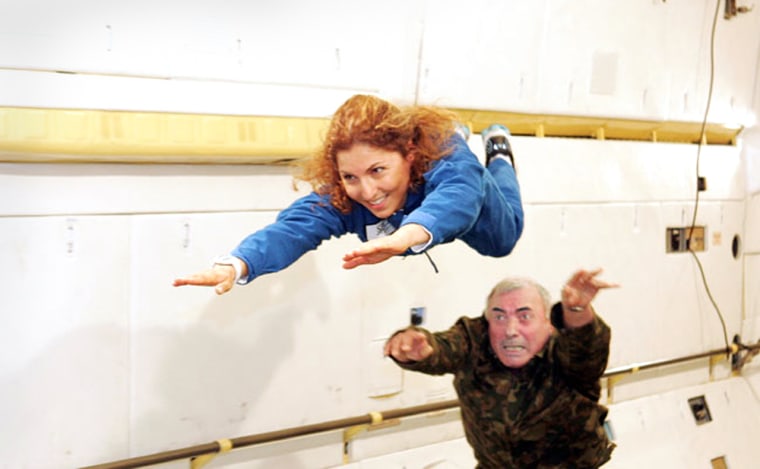For U.S. entrepreneur Anousheh Ansari, failure to reach space is not an option.
With her eyes on a possible 2008 flight to the International Space Station (ISS), Ansari has spent the last few months training as a backup spaceflyer for Japanese businessman Daisuke Enomoto, who is paying $20 million for a 10-day roundtrip to the orbital laboratory currently set to launch on Sept. 14.
“It’s been a wonderful experience for me,” Ansari told reporters at NASA’s Johnson Space Center during a brief break in flight training last month. “I know I’m a backup and am not going to be flying, but the whole learning experience, learning about the program, getting to know some of the astronauts and cosmonauts that could fly…it’s very wonderful.”
Enomoto’s trip – and Ansari’s backup training – were brokered by the Virginia-based firm Space Adventures under an agreement with Russia’s Federal Space Agency. Space Adventures is currently the only firm offering orbital seats for paying customers and has arranged for three previous space tourists to reach the ISS.
A history with space
Ansari, 38, is in line to become the world’s first female space tourist, but takes issue with what she sees as an over-simplistic label to a complicated – yet exciting – experience.
“Tourists are people who just buy a ticket and then they go,” Ansari said, adding that through her training she’s learned that Russia’s Soyuz vehicle is an extremely reliable – if cramped – spacecraft. “They don’t train for six months and try to learn every system.”
But even without her six months of Soyuz training, Ansari is no stranger to human spaceflight.
Ansari’s family made a multimillion-dollar contribution to back the Ansari X Prize, a $10 million suborbital competition for privately-developed, reusable spacecraft. A team led by veteran aerospace designer Burt Rutan and backed by millionaire Paul Allen won the contestin 2004 when their piloted SpaceShipOne vehicle launched into suborbital space twice in two weeks.
Together with her husband Hamid and brother-in-law Amir, Ansari also co-founded the Dallas-based company Prodea to develop the Explorer line of air-launched suborbital vehicles under a partnership with Space Adventures.
Explorer spaceport plans in the United Arab Emirates and Singapore are moving ahead in anticipation of the spacecraft’s development.
Ansari said she leaped at the chance when Space Adventures officials contacted her asking whether she’d be interested in serving as Enomoto’s backup. But while she would welcome the spaceflight opportunity in the off-chance Enomoto is unable to fly next month, Ansari would rather wait for her own dedicated mission.
“If I’m presented with the opportunity to go, I would definitely take it,” Ansari said, adding that she has seats reserved on Rutan’s SpaceShipTwo vehicle under development for British billionaire Sir Richard Branson’s Virgin Galactic spaceliner business. “I have a seat reserved on his plane…whoever flies first.”
Determined for spaceflight
While Ansari is eagerly working toward a spaceflight of her own, she will have to wait in line.
Earlier this year, U.S. businessman and former Microsoft software developer Charles Simonyi signed a contract with Russian space officials to fly toward the ISS in Spring 2007, which would be on the next Soyuz to fly after Enomoto launches with the ISS Expedition 14 crew.
“I’ll wait when my turn comes,” Ansari said.
Malaysia is also hoping to launch its first astronaut aboard a Russian spacecraft in 2007, and any of those plans could be dependent on whether NASA or the European Space Agency will require Soyuz seats to transfer their astronauts to and from the ISS – a variable that hinges on the frequency of space shuttle visits to the orbital platform.
“One good thing is, maybe, I will generate some positive media about the Middle East with everything going on,” said Ansari, who was born in Iran. “I’ve gotten so many calls and e-mails and mail, especially from women in Iran, and other Middle Eastern countries that are excited that someone from [there] gets to go up…and a woman!”
Meanwhile, Ansari said she takes heart in advancements like the recent launch of Genesis-1 – a prototype for inflatable space structures that could lead to orbital hotels or other habitats – by Bigelow Aerospace of Las Vegas, Nevada.
“Right now, that’s the only other potential destination in the future for commercial space travelers to go to,” Ansari said of the potential orbital habitats under development by Bigelow Aerospace. “If you increase the number of people you want to go…the ISS won’t be an ideal location. I’m happy to see somebody building a location that we can fly to.”
But whether she rides a Soyuz to the ISS, an Explorer vehicle, a version of SpaceShipTwo or some other spacecraft, Ansari is confident she’ll slip the bonds of Earth eventually.
“Is there another way to get to space,” Ansari asked with a smile. “Anyway you can fly me, I’ll go.”
